How to open a Roth IRA

You've heard how awesome Roth IRAs are and how starting one now can mean big bucks when you're older. You've even done some research so you have a vague idea of how a Roth IRA works. Now what? How do you actually open a Roth IRA for yourself?
The good news is that it's surprisingly easy to set up a retirement account and begin investing in your future. Here's what to do…
How to open a Roth IRA
- Decide where to open your Roth IRA account. Financial services providers such as Vanguard or Fidelity will have IRA products.
- Gather your information.
- Transfer money into your account.
- Set up an automatic investment plan.
1. Where to Open a Roth IRA
One of the reasons people fret about opening a Roth IRA is because there are so many financial institutions offering IRA products. It's important to search for a company that suits your needs, but how do you evaluate each company's strengths and weaknesses?
Consider reputable Advice
If you already have an investment advisor, ask her for recommendations, but look at other options too. Some banks and credit unions also offer individual retirement accounts. My credit union, for example, has Roth accounts but they're limited to certificates of deposit at 1.50%.
2. Gather Your Information
Gather all your information in one location when you are ready to begin. Most firms provide online applications, but some still require that you download forms and mail or fax them to the company. (If you're opening an IRA through a brick-and-mortar bank or broker, take this information with you.)
From this point, it's just a matter of answering simple questions. The entire process should take about an hour of uninterrupted time. (Actually, you'll probably only need 15 minutes, but allocate more time just to be safe.) Before you begin the application, make sure you have all the documents listed below:
Here's What You Need to Open an Account
- Your social security number.
- Your driver's license or other photo I.D. like a passport.
- Your bank account information — your bank's routing number and your bank account number.
- Your employment information — your employer's name and address.
- Some money. (Depending on where you choose to open your IRA, you may need $25 or as much as $3,000.)
Note: For each beneficiary you choose, you will need to supply their name, social security number, and date of birth as well.
3. Transfer Money Into Your Account
Once you've completed the application process, you will be asked to transfer money to your account. This money will probably earn interest in a money market fund until you choose an investment. [In Part 4 of this series, we'll discuss good investment options for Roth IRAs.]
4. Set Up an Automatic Investment Plan.
I'm a big fan of automatic investment plans. Most of the companies mentioned later in this article offer some sort of program that will pull money from your bank account every month to invest in the stocks or mutual funds you designate. By setting aside $50 or $100 or $500 in this way, saving becomes a habit. You don't notice the money is missing. It's a regular expense that just becomes incorporated into your budget.
A final note: Opening a new account usually is quick and simple. However, be aware that it may take a few weeks before you can start trading. That's because they will wait for checks you send to properly clear the bank.
Ongoing IRA account transactions at banks, brokerages or mutual fund families happen quickly, but they all take some time to activate a new account. In other words, don't become impatient if you can't buy things right away.
Related >> IRA Contribution Limits, Deadlines and Deductions
Before You Invest
There are two things you should take care of before opening a Roth IRA:
- Tuck away at least $1,000 in a savings account for emergencies.
- Pay off your credit card debt. At the very least, make a significant dent in your debt and have a plan for its elimination. (I chronicled my choice between debt and savings here.)
Related >> Which online high-yield savings account & money market is best?
Related >> Real-life choices: Retirement savings vs. debt reduction
An Excellent Way to Begin Your Retirement Savings
- When you've finished paying off your debt, take the amount you were using for debt reduction each month and, instead of spending it, stick it into a retirement account.
You've already developed the habit of using the money to improve your financial life. This is just another way to do it!
Consider Taking a More Active Role
If you're willing to make some decisions on your own, you can open a self-directed IRA through a mutual fund company or through an online discount brokerage.
In general, you have two choices:
- A mutual fund family, like Vanguard or Fidelity, which will open an IRA account for free and sell you their funds for free. The benefit is that you pay no commissions, but the downside is you can only buy the funds they sell.
- A brokerage, which allows you to pick any index fund, managed mutual fund, or individual stocks and/or bonds but may charge a commission on each trade. The major online brokerages (E-Trade, TD Ameritrade, etc.) usually have no fees to open an IRA but will charge around $10 or less per transaction for most transactions.
How to Evaluate a Roth IRA provider
- Is there a minimum initial investment?
- Does the company offer automatic contributions?
- Are there minimum contributions?
- What types of fees are assessed to the account?
- What investment options are available — stocks? mutual funds? real estate?
- Is it possible to download statements automatically to your money management program?
- How reputable is the provider?
Mutual Fund Family
If you decide to go with a mutual fund family, many people recommend starting at one of the big three Vanguard, Fidelity, or T. Rowe Price because of the large variety of managed and indexed funds they offer. If mutual funds (indexed or managed) are the cornerstone of your investment strategy, it makes the most sense to go with one of the major fund families.
For those focusing on index funds, Vanguard is the most logical choice, because they specialize in index funds and offer the widest variety. They actually created index funds to begin with, and their costs tend to be the lowest.
Click here to open a Roth IRA at Vanguard.

For those who prefer managed mutual funds over index funds, your best approach is to go to a review site like Morningstar or Zacks to see which of the funds that pursue what you have in mind (e.g., foreign stocks, domestic bonds, etc.) perform the best.
Click here to open a Roth IRA with Fidelity.
All the major mutual fund families make it easy to open no-cost accounts. Simply go to their website and follow their instructions. But there are still other places that you can open a Roth IRA.
Click here to open an IRA at T. Rowe Price.
Discount Brokers
Discount brokers appeal to many people because they have a low barrier to entry. They offer lower fees than traditional brokers because they don't have research departments and they don't offer investment advice. They act purely as middlemen for trading in the market.
The primary benefit of using a broker is that you can pick from many different mutual funds or, if you prefer, individual stocks or bonds.
How to Bridge a Gap
Discount brokers are a good option if you are short on cash. Most of them will also offer a cash account, similar to a savings account. You can use that account to accumulate the money necessary to meet the minimum initial deposit.
Online discount brokers want your IRA business and, consequently, they make it very easy to open an account. You can compare their fine print details, but for the most part, their pricing is very similar.
The major players in the discount brokerage space are E-Trade, Scottrade, and TD Ameritrade. Simply visit their home page and look for the link offering a no-cost IRA account. Some have minimum deposits of $500 or so; but if you commit to a monthly automated contribution, many will waive that requirement.
Don't Delay Because of These Misconceptions
I always believed opening a retirement account was difficult, but that's all there is to it really. The most difficult part is deciding where to open your account. Set aside an hour or two some Saturday morning to explore your options over a cup of coffee. With some research, you should be able to find a company and program that fits your place in life.
I also used to think, I don't have money to invest. Last year I forced myself to find the time and the cash to open a Roth IRA, and I can say that it has been one of the best financial decisions I've ever made.
The GRS Introduction to Roth IRA Series
Understanding how important it is to get started saving for retirement, check out the rest of our Roth IRA series to learn about how to start your Roth IRA, which investments are best, and other general questions about these great accounts.
Part 1: The extraordinary power of compound interest
Part 2: What is a Roth IRA and why should you care?
Part 3: How to open a Roth IRA (and where to do it)
Part 4: Which investments are best for a Roth IRA?
Part 5: Questions and answers about Roth IRAs
Become A Money Boss And Join 15,000 Others
Subscribe to the GRS Insider (FREE) and we’ll give you a copy of the Money Boss Manifesto (also FREE)



